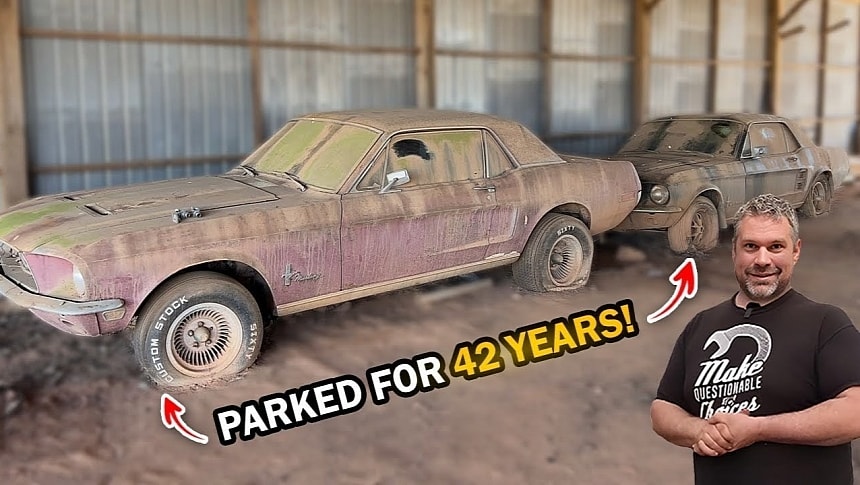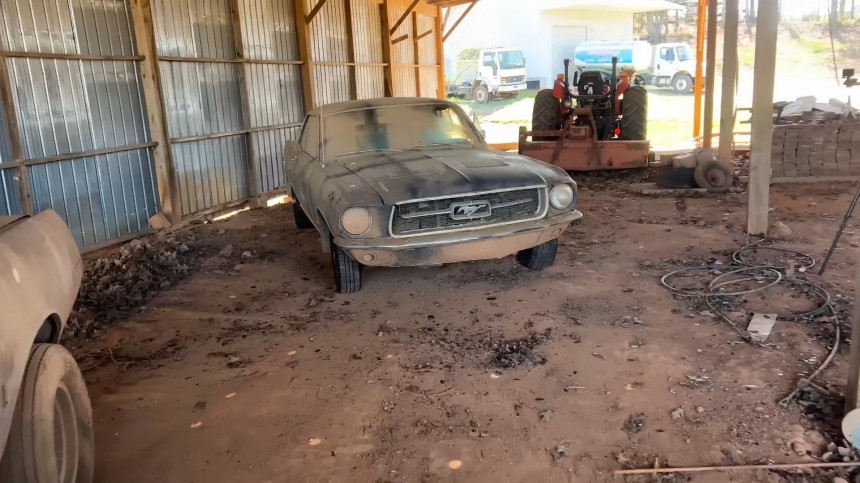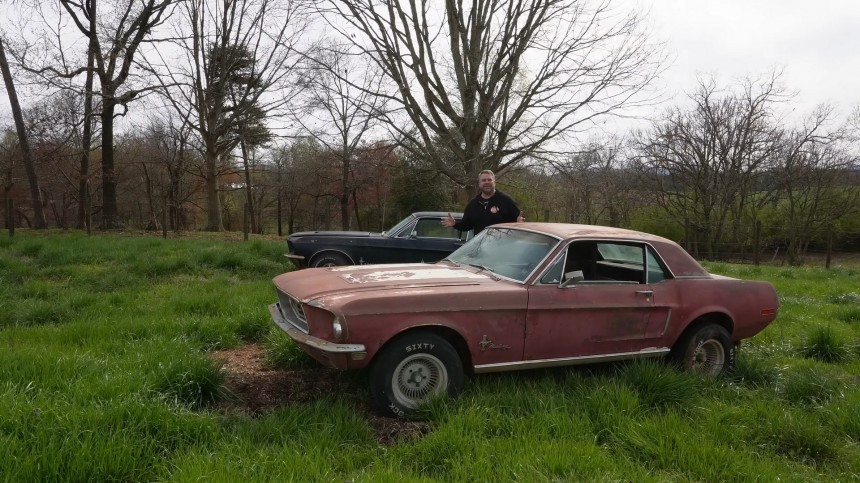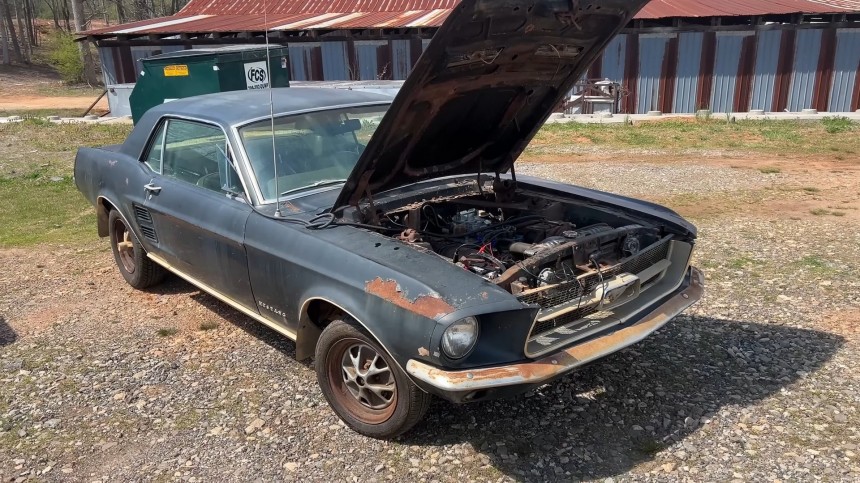Coming to the stage as a little more than a more youth-oriented spin-off from the compact Ford Falcon, the Mustang quickly rose to stardom. It became one of the most – if not the most – emblematic automobiles Made in America. The 1964-1973 generation was by far the most popular (sorry, fox body fans!), and barn finds from that era are still emerging after decades of collecting oblivion dust.
The Mustang appeared in the Ford lineup because the Chevrolet Corvair didn’t have a direct competitor wearing the FoMoCo badge. Initially, the rebellious pony car was supposed to be a sporty Falcon, and almost no one among the Blue Oval brass was particularly enthusiastic about the new model. However, when bean counters drew the line at the end of 1964, they saw that the car had surpassed sales estimates by an obscenely high margin.
Launched on April 17, 1964, the Mustang was expected to sell around 100,000 examples yearly. On April 18 of that same year, all forecasts were set on fire after the Ford execs received the news report. Twenty-two thousand buyers placed an order on the first day of the Mustang’s official existence. Within three months, the predictions were met and then left behind.
Over six generations, the iconic American pony sold north of 10 million units. The seventh generation, launched with the 2024 model, will only solidify the Mustang’s aura of one of the most emblematic automobiles in history. They’re absolutely everything a car can possibly be, from cult idols to revered classics to movie stars to coveted collectibles to junkyard wrecks to barn finds to restoration projects.
With such high overall production numbers, a classic Mustang (by which I mean the first-generation cars, to be clear about this aspect) is not a rare sight by anyone’s standards. And yet, whenever somebody mentions ‘Ford Mustang’ and ‘barn find’ in the same sentence, everyone else's attention spans tunnel toward the speaker.
Take Jared Pink from the Questionable Garage YouTube channel as a concrete example: he’s got his hands on not one but two Mustangs that have been collecting barn dust since 1981-1982. To be exact, a very generous layer of ‘time powder’ because the cars haven’t been used since and only pushed around occasionally.
The two Fords are both notchbacks — don’t sound so disappointed. The hardtop body style was the most popular by far, despite the fastback’s (‘SportsRoof’ was the official terminology) much higher appeal. They’re also the pride and joy of a car guy who owns them both and asked for the YouTuber’s help getting them back on the road.
The plan is fairly straightforward – the gearhead who enjoyed the two ‘Stangs four decades ago was forced to put them aside for this long while but never planned to part ways with them. Quite the contrary, the long-time owner wants to hand them over to his grandkids as family heirlooms. Hats off to that, Sir, whoever you are!
The cars are consecutive years—one from 1967, the other from 1968—and differ slightly in purpose. The 289 cubic-inch V8 (4.7 liters) from ’67 was a regular pony car that the owner drove around in daily. The 302 V8 (technically 4.9 liters, but commonly identified as a 'five-liter' in Ford's literature) from a year later was slightly modified with fatter wheels and raised suspension for some smiles per gallon experiences.
Predictably, after sitting in barns for forty years, none of them are running and driving, but they are in fairly solid condition. The engines aren’t seized and will turn by hand, but the standard issues plague both. Clogged carbs (the 289’s two-barrel cleans up fine, but the four-barrel carburetor on the 302 takes a little more convincing).
An ancient combustion proverb says, ‘If you can’t push it, don’t buy it.’ Luckily, the cars roll on their tires (once fresh air is forced into them). Jared decides to take the long, complicated route of removing the brakes from all eight wheels to make things a little easier. After a few days of wrenching and rebuilding, the Mustangs fired up for the first time since Jimmy Carter handed over the keys to the White House (and the rest of America) to Ronald Reagan.
Both cars are fairly solid – with the usual signs of dry aging visible under the hood and pretty much everywhere else. However, the important aspect here is that they’re still alive and in one piece. The 1967 is one of the 325,853 hardtops built for the model year out of 472,121 Ford Mustangs (notchback, fastback, and convertible). Its 289-2V was the low-entry eight-cylinder motor with 200 hp and 282 lb/ft (203 PS, 382 Nm), although Ford was exuberantly marketing it as the ‘Challenger V8.’ Maybe that wasn’t the greatest choice of names after 1966, wouldn't you say?
The 1968 hot-rod has the more spirited 302-4V V8 under the hood, with 230 hp and 229 lb-ft (234 PS, 310 Nm). 1968 was a turning point for the Mustang power teams: after the 1967s got seriously outgunned by competition (three engines were offered: a 200-cube / 3.3-liter Six and two V8s—the 289 and a 390-cubic-inch big-block / 6.4 liters), Ford came back with a vengeance.
The 302 was introduced along with the Six and the 289, and the 427 (7.0-liter) was added to the list. Mid-model-year, the 428 Cobra Jet stepped up after the expensive 427 failed to sell a single example. Although still strong, sales for the 1968 Mustang went down abruptly, free-falling to 317,404. Compared to the all-time best recorded in 1966 (607,568), the drop was cataclysmic – 290,000 units in two years. Again, the traditional hardtop was the sales workhorse in 1968, with 233,472 built on that body style.
Launched on April 17, 1964, the Mustang was expected to sell around 100,000 examples yearly. On April 18 of that same year, all forecasts were set on fire after the Ford execs received the news report. Twenty-two thousand buyers placed an order on the first day of the Mustang’s official existence. Within three months, the predictions were met and then left behind.
Over six generations, the iconic American pony sold north of 10 million units. The seventh generation, launched with the 2024 model, will only solidify the Mustang’s aura of one of the most emblematic automobiles in history. They’re absolutely everything a car can possibly be, from cult idols to revered classics to movie stars to coveted collectibles to junkyard wrecks to barn finds to restoration projects.
Take Jared Pink from the Questionable Garage YouTube channel as a concrete example: he’s got his hands on not one but two Mustangs that have been collecting barn dust since 1981-1982. To be exact, a very generous layer of ‘time powder’ because the cars haven’t been used since and only pushed around occasionally.
The two Fords are both notchbacks — don’t sound so disappointed. The hardtop body style was the most popular by far, despite the fastback’s (‘SportsRoof’ was the official terminology) much higher appeal. They’re also the pride and joy of a car guy who owns them both and asked for the YouTuber’s help getting them back on the road.
The cars are consecutive years—one from 1967, the other from 1968—and differ slightly in purpose. The 289 cubic-inch V8 (4.7 liters) from ’67 was a regular pony car that the owner drove around in daily. The 302 V8 (technically 4.9 liters, but commonly identified as a 'five-liter' in Ford's literature) from a year later was slightly modified with fatter wheels and raised suspension for some smiles per gallon experiences.
Predictably, after sitting in barns for forty years, none of them are running and driving, but they are in fairly solid condition. The engines aren’t seized and will turn by hand, but the standard issues plague both. Clogged carbs (the 289’s two-barrel cleans up fine, but the four-barrel carburetor on the 302 takes a little more convincing).
Both cars are fairly solid – with the usual signs of dry aging visible under the hood and pretty much everywhere else. However, the important aspect here is that they’re still alive and in one piece. The 1967 is one of the 325,853 hardtops built for the model year out of 472,121 Ford Mustangs (notchback, fastback, and convertible). Its 289-2V was the low-entry eight-cylinder motor with 200 hp and 282 lb/ft (203 PS, 382 Nm), although Ford was exuberantly marketing it as the ‘Challenger V8.’ Maybe that wasn’t the greatest choice of names after 1966, wouldn't you say?
The 1968 hot-rod has the more spirited 302-4V V8 under the hood, with 230 hp and 229 lb-ft (234 PS, 310 Nm). 1968 was a turning point for the Mustang power teams: after the 1967s got seriously outgunned by competition (three engines were offered: a 200-cube / 3.3-liter Six and two V8s—the 289 and a 390-cubic-inch big-block / 6.4 liters), Ford came back with a vengeance.
The 302 was introduced along with the Six and the 289, and the 427 (7.0-liter) was added to the list. Mid-model-year, the 428 Cobra Jet stepped up after the expensive 427 failed to sell a single example. Although still strong, sales for the 1968 Mustang went down abruptly, free-falling to 317,404. Compared to the all-time best recorded in 1966 (607,568), the drop was cataclysmic – 290,000 units in two years. Again, the traditional hardtop was the sales workhorse in 1968, with 233,472 built on that body style.































